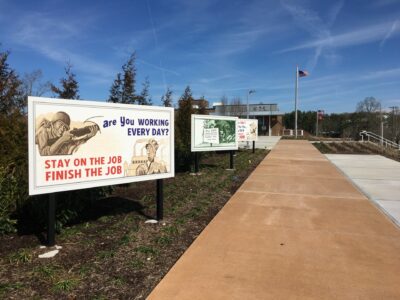A race against time: recording oral history at Oak Ridge
10 December 2020 – Ray Smith
The K-25 History Center’s oral history facility is a quiet room near the main entrance, equipped with an easy-to-use interface that makes leaving an oral history simple, yet provides high-quality results. This latest advance in technique is yet another example of the important role of oral history in capturing Oak Ridge history.
Oak Ridge, Tennessee, was a substantial contributor to the World War II-era Manhattan Project, as sixty cents of every dollar for the secret mission was spent there, primarily enriching Uranium-235 for “Little Boy,” the world’s first atomic bomb used in warfare. The Graphite Reactor developed at that time in Oak Ridge also proved that plutonium, the other material suitable for an atomic bomb, could be produced in a uranium reactor. Those advances would have a worldwide impact on wars and energy production, even though Oak Ridge didn’t exist on maps from the World War II-era through the middle of the twentieth century. While much has been written about the Manhattan Project and Oak Ridge, the vast history of that era is still only partially documented. Official records are becoming public, and government institutions can tell a portion of the city’s history, but it’s the people who lived during that time that fill that story out with their oral histories.

World War II-era billboards from the K-25 facility in Oak Ridge, Tennessee border the sidewalk to the museum’s entrance. Photo credit: K-25 Museum.
The missing links in the Manhattan Project history are personal and intimate oral histories from the actual participants in that mission. That includes the stories of people who “punched the clock” and developed technology in buildings with code names such as K-25 or Y-12, primary production sites at Oak Ridge. Progress has been made lately by documenting oral histories online at the Atomic Heritage Foundation and Oak Ridge Public Library. But, it’s a race against time.
Historians recently realized that the opportunity to record the experiences of participants was disappearing from Oak Ridge, where many people stayed after retiring from working in the labs and factories that served the Manhattan Project and World War II. And the few remaining members of that generation are getting older, so it’s important to act fast. Therefore, the Smithsonian-affiliated American Museum of Science and Energy and its K-25 History Center have been working briskly with Oak Ridge historians to capture oral history. And the K-25 History Center began a new approach to capture oral histories through an interactive, automated recording booth.
The K-25 History Center opened in February 2020 with a dedicated room to collect oral histories, archive them and make them available to the public. A video-based interactive system walks people through the process with questions created by experienced oral history interviewers. Attention was paid to make the room comfortable and quiet for interviewees so they can feel at ease while telling their life stories. The interface feels similar to a Zoom conference or Facetime chat; with automated questions to prompt the guests as they speak into a microphone before a camera. Two programs were used on the technical back end, XAMPP and Red5, in conjunction with the graphic user interface that walks people through the interview. The equipment itself is somewhat scaled back, so the interviewee doesn’t feel overwhelmed.
People can bring their friends or family members with stories from World War II at Oak Ridge to the K-25 History Center. They’ll be guided to a comfortable room once there. The software for the self-guided interface is simple, easy to use, and records oral histories without any hassle. Already people have used the system as a way to record stories from loved ones to enjoy as a keepsake for future generations.
But even as that innovative effort is underway, the stakes are high. A generation of people who lived through the Manhattan Project and World War II are continually disappearing. Automated efforts to document oral history at the K-25 History Center can help, but many people have already been lost. And, looking forward, historians must prepare to log stories from generations who lived through the Cold War-era.
Finally, it’s important to emphasize the importance of telling these stories. Often, older generations will defer when asked for their stories with a response like, “Aw, I don’t have anything to say,” or “I never did anything to talk about.” When one hears that, they should reaffirm the importance of recording oral histories. The generation that lived through World War II still has stories to tell, and those who contribute will be proud of the finished product when they complete the oral history recording at the K-25 History Center.
There are also over 800 oral histories archived in the Center for Oak Ridge Oral History. Those who would like to provide an oral history should contact the K-25 History Center.
~ Ray Smith currently serves as Historian for the City of Oak Ridge, Tennessee, and is a Commissioner on the Tennessee Historical Commission. In 2017, he retired from the Y-12 National Security Complex as the Y-12 Historian.



